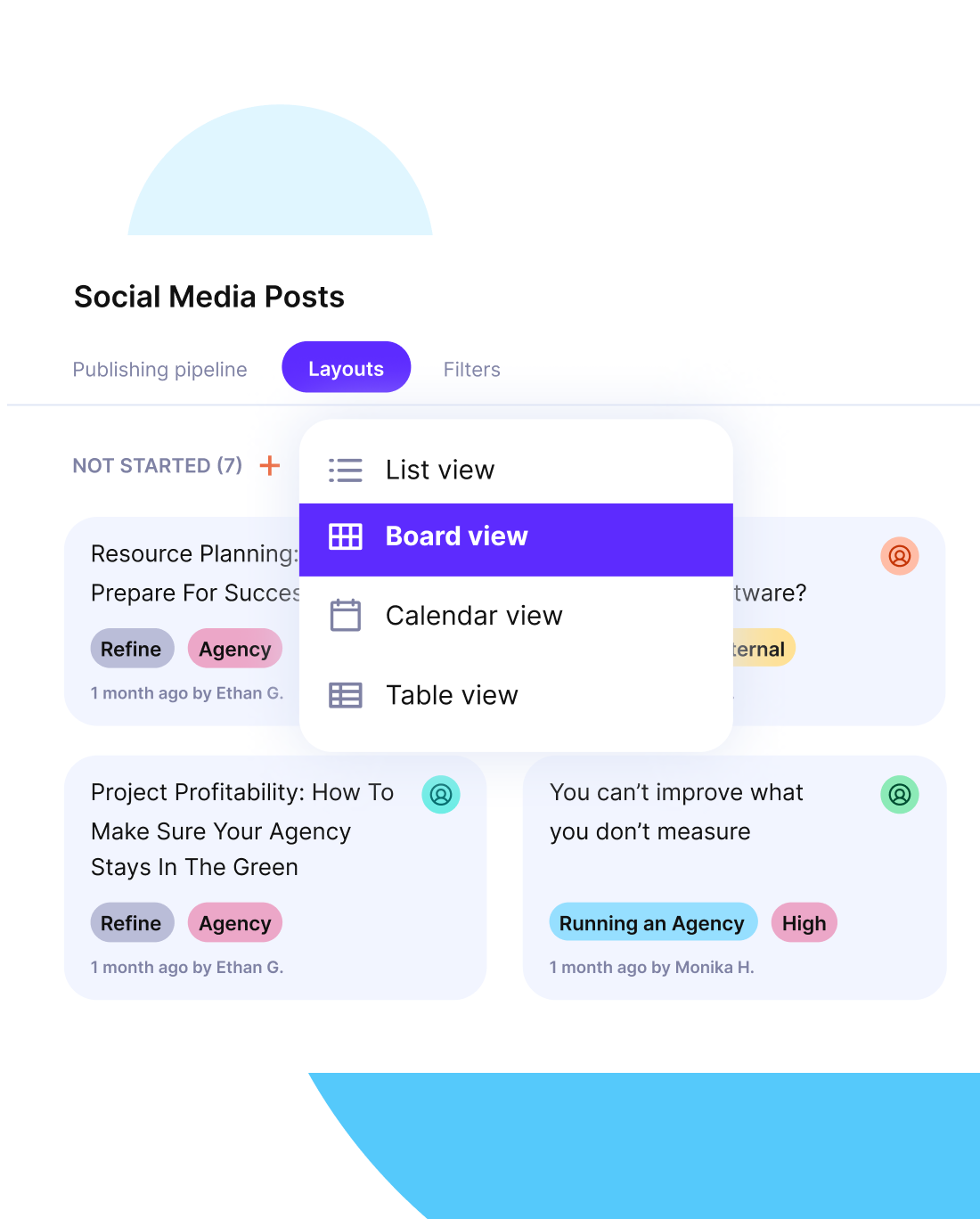What Is Client Relationship Management CRM? Detailed Guide
Client relationship management (CRM) helps companies and teams organize client needs, keep communication on track, and prevent work from slipping away from the desired outcome.
In this guide, you’ll learn what CRM is, why it matters for project management, the benefits, common challenges with fixes, how to implement and apply best practices, ways to measure ROI, real-world examples, and how to choose the right tools with cost in mind.
Key Takeaways
- Client relationship management only works when one CRM holds a shared context, has clear owners, and maintains a simple data model that everyone can follow.
- Adoption matters more than features. Train the team, agree on who updates what, and set a monthly cleanup to keep information accurate.
- Automate reminders and logging, but not the customer relationship. Keep outreach human, review automation quarterly, and drop anything that feels robotic.
- Prove value with metrics: track retention, expansion revenue, time to first value, and NPS or CSAT. Set a baseline, define targets, and review results every month.
What is Client Relationship Management?
Client relationship management is the practice of combining strategy, process, and technology to manage how you work with clients from the first conversation through long-term delivery. Companies use CRM to collect and organize client information in one place, so teams can coordinate updates, track progress, and strengthen customer relationships.
A CRM is more than software. It defines who is responsible for updates, sets rules for how client details are recorded, and creates a repeatable system so the client experience feels consistent across every project and customer interaction.
What Does Client Relationship Management CRM Do?
Client relationship management gives your team structure for everyday client work. It takes scattered details and organizes them into a clear workflow. Together, these functions keep work moving, reduce errors, and support consistent client experiences without adding unnecessary overhead.
- It stores contact details and customer information in one place, so no one wastes time digging through emails.
- It logs meeting notes and decisions, so important context is never lost.
- Pipelines map the stage of each deal, making it obvious what needs attention.
- Ownership tags assign tasks to the right person, reducing confusion.
- Alerts signal when a follow-up is due, so clients never feel ignored.
Why Is Managing Client Relationships Important for Companies?
Client relationship management is important because it improves outcomes clients feel every day: reliable updates, faster responses, and trust that work is under control. For services firms, a clear CRM process keeps delivery teams aligned with what was promised in sales.
We will talk more about the benefits of excellent client management in the next part.
What Are the Benefits of Managing Client Relationships?
Client relationship management delivers results that directly impact client satisfaction. It helps teams improve retention, speed up responses, and make better decisions by working from one reliable source of truth.
Here are some of the most important benefits:
1. Stronger retention and satisfaction: When clients feel informed, they stay longer. A Zippia study revealed that companies that implemented CRM systems reported a 47% increase in customer retention and satisfaction. Start by sending regular progress updates and sharing customer feedback summaries.
2. Faster, clearer responses: With reminders, logged decisions, and next steps visible in one system, teams answer clients more quickly. Create templates for common questions and assign clear owners.
3. Better forecasting and decision-making: Reliable data reveals at-risk clients and shows where to focus resources. McKinsey found that integrating CRM with AI and data infrastructure can drive large gains in productivity and customer experience.
4. Greater operational efficiency: Less time wasted chasing lost notes or duplicate records.
Try Productive’s CRM
What Are the Common CRM Challenges? (+ How To Solve Them)
The common CRM challenges are a lack of discipline, unclear rules for use, and overcomplicating the system. Adoption fails when teams try to track too much, don’t agree on ownership, or lean too heavily on automation.
These issues are avoidable if the setup stays simple, responsibilities are clear, and automation supports rather than replaces personal communication.

Below are three frequent failure modes and practical ways to solve them:
Challenge 1: Data overload and poor adoption
Teams often overload a CRM with too many fields or inconsistent entries, leading to messy information and unclear ownership. The root cause is usually a lack of agreement on what data really matters, which creates confusion and slows adoption.
For example, one team might log client needs in spreadsheets while another relies on email threads, leaving gaps and duplicates. This makes the CRM harder to trust and discourages use.
How to solve:
Start with a minimum viable data model that includes only essential fields. Define clear ownership for updates and decide who manages which parts of the system.
Schedule a monthly cleanup to catch duplicates or outdated entries. In platforms like Productive, you can track who last updated a task, set different permissions and keep accountability visible.

Set system or custom permission sets for your team, contractors, and clients.
Challenge 2: Lack of team alignment
When sales promises do not match what delivery can provide, clients experience delays and broken trust. The root cause is usually poor client communication across teams and no single system for client updates.
For example, one group may assure weekly deliverables while another plans for a two-week cycle. This mismatch hurts customer relationships and creates friction inside the company.
How to solve:
Create a shared playbook that defines commitments, reporting cadence, and escalation rules. Use one hub for status updates so everyone sees the same information.
In Productive, both sales and delivery can work from the same pipeline and handoff template, which reduces errors and improves relationship management.
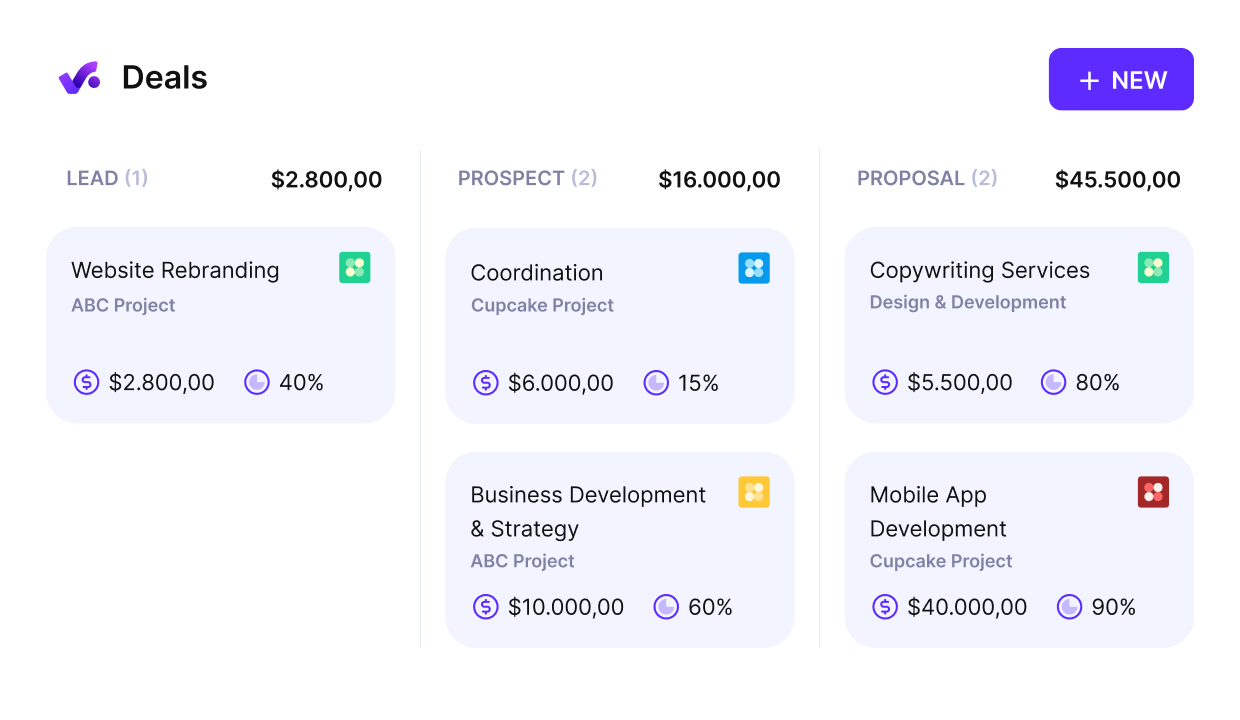
Get an overview of your sales pipeline and connect it to available capacity.
Challenge 3: Over-automation hurts relationships
Too much automation makes communication feel cold and generic. The root cause is relying on sequences to replace human judgment. Clients notice when every email looks the same or when follow-ups are triggered at the wrong moment.
This weakens relationship building and makes teams look inattentive to actual needs.
How to solve:
Limit automation to reminders, scheduling, and data logging. Keep client outreach personal, timely, and context-aware. Review automation quarterly to cut steps that feel robotic.
In Productive, you can automate task alerts while still keeping space for tailored updates, which balances efficiency with authenticity.
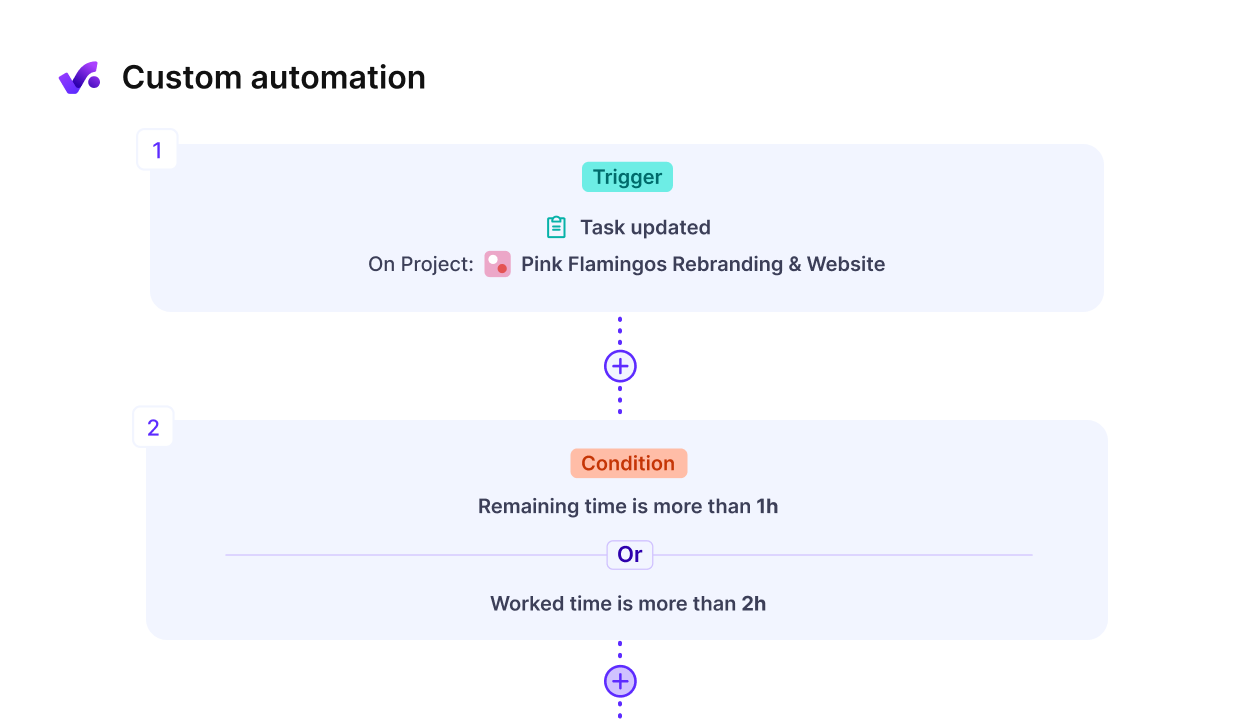
Automate the manual non-billable work with easy-to-use custom automations.
How To Implement a CRM System?
To implement a crm system successfully, start by defining what you need it to do, then build around that. Implementation isn’t about installing software; it’s about setting clear rules, ownership, and workflows that people will actually follow.
Once those foundations are clear, the technical rollout becomes much easier to manage.
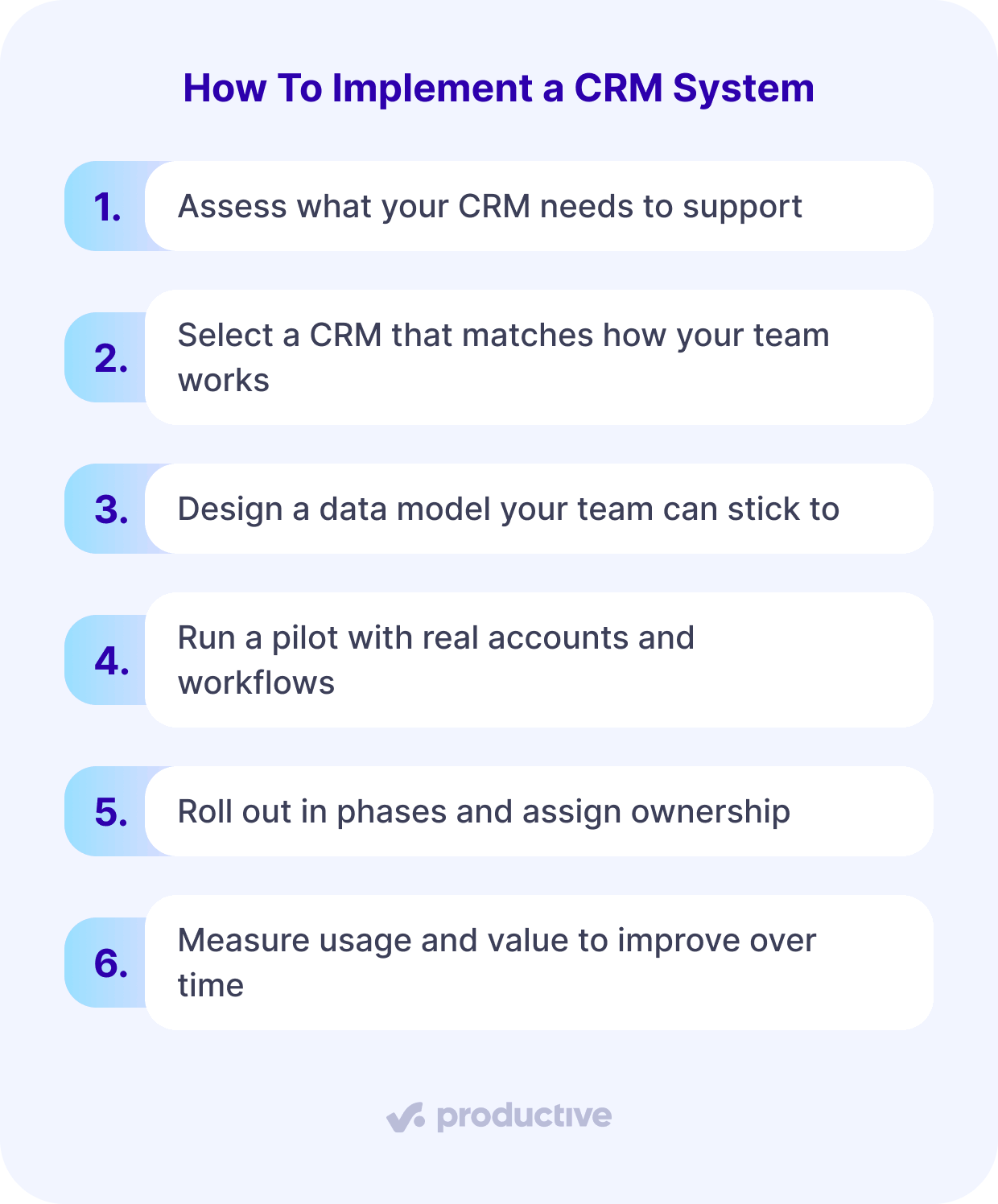
Below are six practical steps you can follow to take your customer management system from setup to adoption.
Step 1: Assess what your CRM needs to support
Start by identifying the core needs your CRM must support. Talk to sales, delivery, and account teams to find out what client information they rely on daily. Then, write down the 5-7 most important data points you need to track.
These are things like contact info, last touchpoint, stage in lifecycle, or upcoming renewals.
Avoid vague or overly broad fields that rarely get filled in. This step isn’t just about organizing customer data; it’s about reducing noise so the CRM stays useful and gets adopted.
If you’re not sure where to start, look at your last five client handoffs and flag what information was missing or delayed. That’s your starting point.
Step 2: Select a CRM that matches how your team works
Choosing a CRM platform is about matching it to how your team already works. Don’t start with a features list, but with your workflows. Map out how you move from sales to delivery, and look for gaps that the CRM should fill. Then evaluate tools by how well they support that flow.
You’ll want to find out:
- Can team members update information quickly without training?
- Can account managers track deal status and project delivery in the same view?
- Can reports be filtered by service type, deal owner, or timeline?
These questions help you spot whether a tool supports the decisions and handoffs your team makes every day.
Make a short list of must-have features, like shared timelines, internal comments, or email integrations. Demo 2–3 platforms using real customer data or test cases. Watch where people get stuck.
Finally, avoid chasing shiny features you won’t use in the first 3 months. A smaller, cleaner tool that gets adopted is worth more than a complex system no one logs into.
Step 3: Design a data model your team can stick to
Start by deciding which fields are essential for tracking and reporting across the full client lifecycle. Choose 5–7 fields that are non-negotiable (like lead source, project type, last contact date, and account owner).
Then, standardize naming conventions so reporting isn’t fragmented. For example, don’t let some teams call it “Design Phase” while others use “Creative Start.”
Map how information flows from sales to delivery to finance: What needs to be captured at each step to avoid rework or confusion? Document this as a shared reference and walk teams through it.
Step 4: Run a pilot with real accounts and workflows
Before rolling out your CRM to the entire company, run a small pilot with one team or a few client accounts. Choose a group that’s open to testing and document how they use the system day to day.
Look for where they hesitate, what they forget to update, and what gets logged inconsistently. Meet weekly to gather feedback, and have someone take ownership of refining the setup. This is your best chance to spot friction before it affects the whole company.
Step 5: Roll out in phases and assign ownership
Once the pilot is refined, roll out the CRM in phases. Start with one team or department and build momentum from there. Make sure everyone gets hands-on training (not just a slide deck). Show real examples of how they’ll use it day to day.
Assign clear ownership of each field or record type. For instance, account managers own client notes; project leads update timelines. Define what “done” looks like for each type of update.
Set up permissions so each role sees only what they need. This keeps the interface clean and adoption high. In Productive, you can use role-based views and access levels to streamline rollout without adding friction.
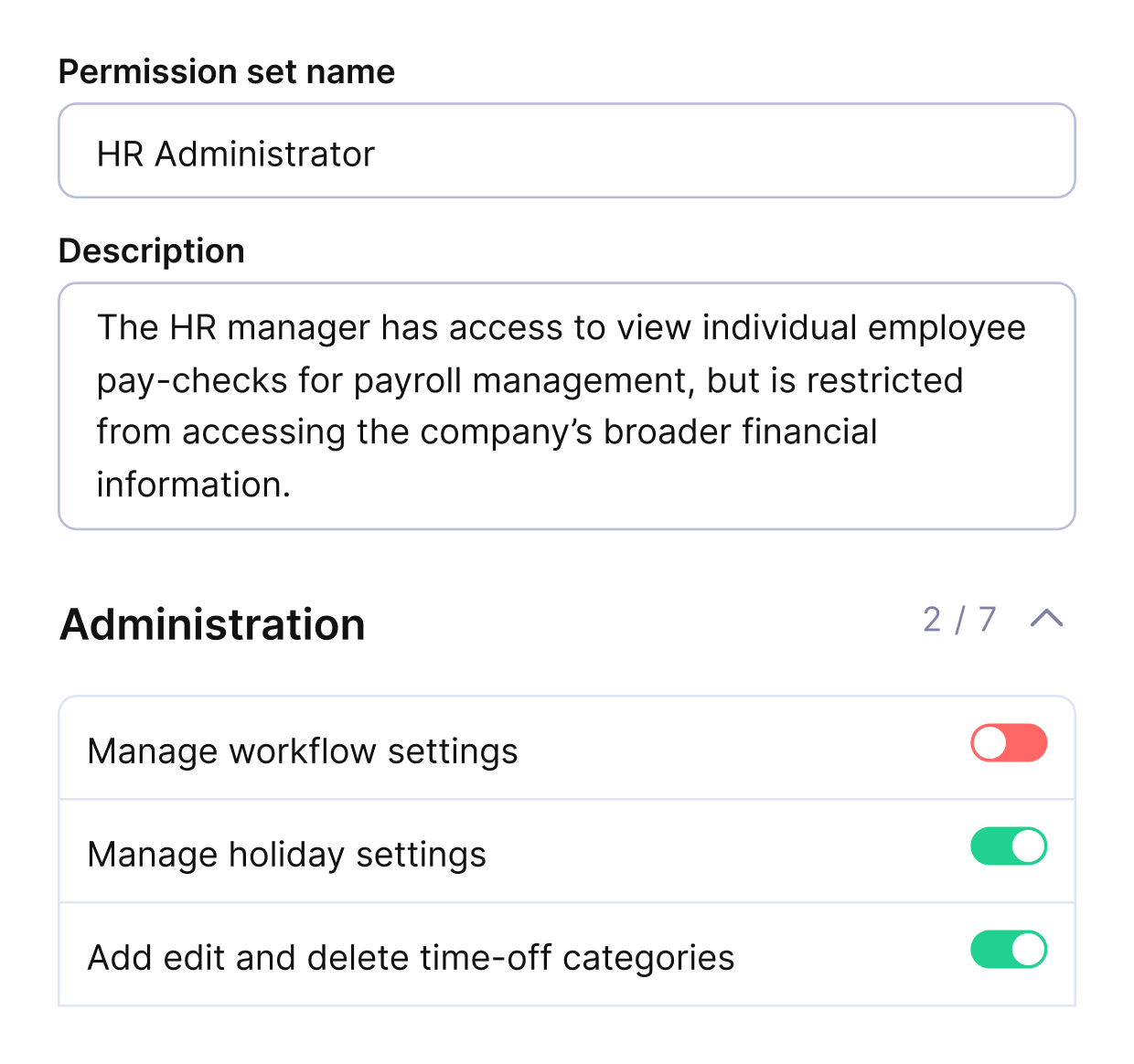
Ad specific permissions for each user.
Step 6: Measure usage and value to improve over time
Measuring success is how you know whether your CRM setup is working. Don’t wait for gut feel. Track adoption rates, usage patterns, and client outcomes using data your team already generates.
Start with three basic metrics: percentage of records fully filled in, number of overdue tasks, and time from lead to kickoff. Look at whether projects are starting faster or if fewer updates are missing.
Use these signals to spot gaps in training or workflow. For example, if the update frequency drops off after onboarding, the issue may be unclear ownership. Schedule monthly reviews to revisit setup and make small improvements. A CRM that gets updated, monitored, and improved is one that actually delivers value.
What Are the Best Practices for Client Relationship Management?
The best practices for client relationship management include proactive communication, centralizing client information, personalizing the client experience, and closing the loop on feedback.
These are habits that build clarity, trust, and consistency into how your team works with clients.
They’re not one-time tasks but repeatable actions that help the CRM stay useful and effective over time. Once you’ve implemented a CRM system, the next step is to make these practices routine.
Here are four essential best practices and how to apply each one in real life.
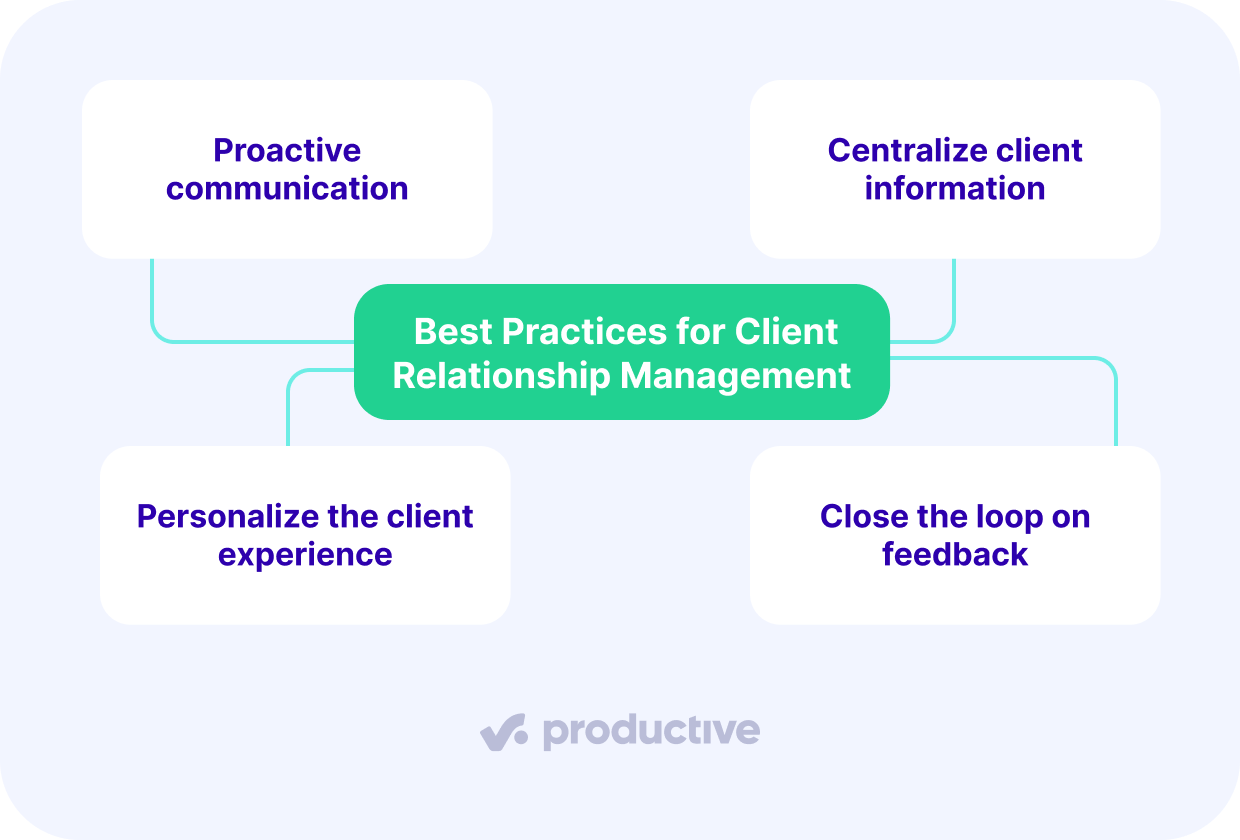
1. Proactive communication
Send updates on a regular cadence (weekly works well for most service teams). Each update should include what’s been done, what’s coming next, and any open questions or risks.
Use a standard agenda for review calls, so the client always knows what to expect.
Agree on expected response times for emails or messages. For example, you might commit to replying within 24 hours on weekdays. Document these expectations in your kickoff notes and revisit them during check-ins.
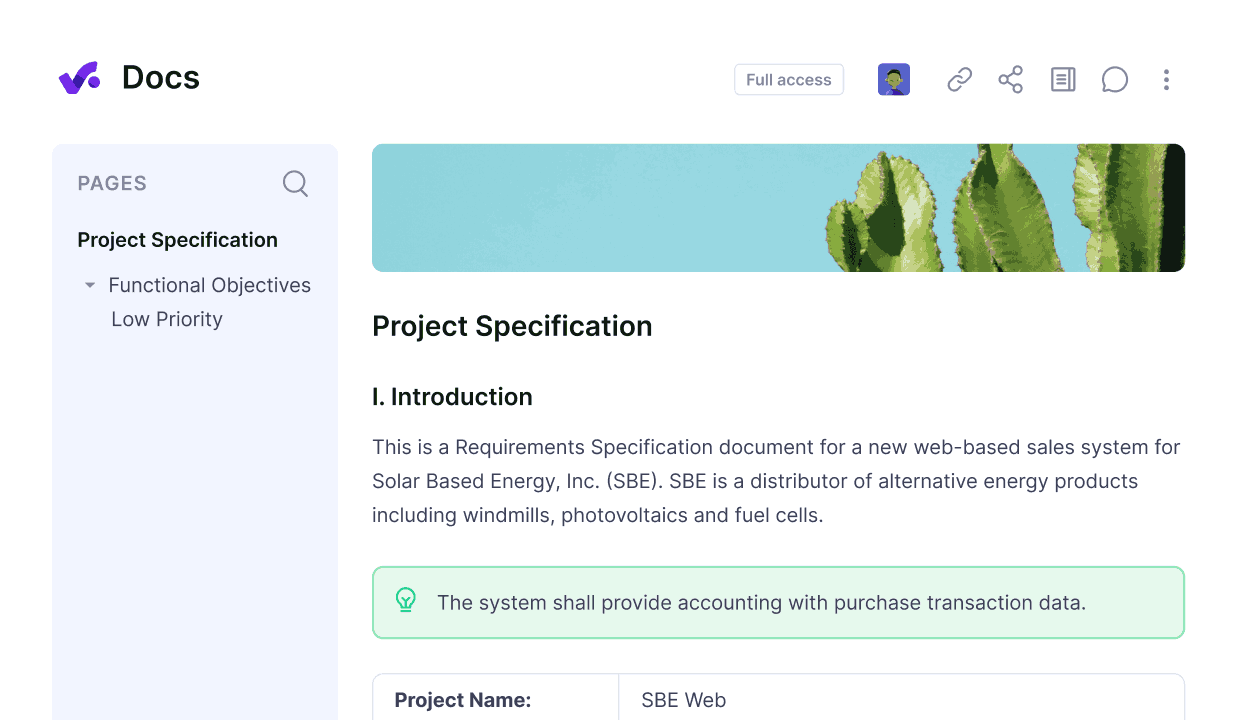
Share, edit, and collaborate on all documentation in a centralized workspace.
2. Centralize client information
Decide what “source of truth” means for your business. Track key fields like contract status, main point of contact, last meeting date, and project stage. Use these consistently across all teams.
Avoid letting customer data live in multiple systems. Instead, connect your CRM with tools you already use, like email or project management (so updates flow into one place). In Productive, you can customize fields and dashboards, so everyone sees the same up-to-date information.
3. Personalize the client experience
Use CRM data to segment your communication. For example, send different project updates based on client type, engagement level, or customer service tier. High-touch clients might get weekly updates and a quarterly roadmap session, while smaller accounts get monthly check-ins.
You can also tailor delivery workflows based on industry.
4. Close the loop on feedback
Build feedback into your project closeout or quarterly review process. Use short NPS or customer satisfaction surveys, then summarize the results in internal notes or a shared doc. More importantly, take visible action.
Log what’s changing and let the client know. For example, if a client asks for more context in status updates, add a line in your templates.
How Do You Measure ROI in Client Relationship Management?
The ROI of client relationship management is measured by how well it helps you retain clients, expand revenue, and reduce delivery friction.
Start with key performance indicators of customer relationship management, like:
- Client retention rate (customer loyalty)
- Expansion revenue from existing clients
- Average cycle time from a deal in the sales funnel to delivery of the customer service
- Net Promoter Score (NPS) or customer experience satisfaction surveys
Example:
If your average client stays for 8 months and pays $4,000 per month, improving retention by 2 months adds $8,000 in lifetime value. Multiply that across 10 clients and you’ve added $80,000 in revenue without extra acquisition spend.
To make these numbers meaningful, track them month over month using CRM data. In Productive, you can get hard data and generate a client profitability analysis. This lets you tie relationship management directly to revenue and operational efficiency.
What Are Examples of Client Relationship Management in Action?
Reading Room, a digital experience agency, adopted Productive’s CRM to bring its sales pipeline and delivery operations into one place. Their story shows how centralizing client data and pipeline visibility improves both sales and operations.
With Productive, I got the information I needed; I can now see tasks, utilization, and our sales pipeline, and I can react more quickly.
The problem: disconnected sales and reporting
Before Productive, Reading Room’s sales pipeline was separate from invoicing and delivery. They lacked granularity and couldn’t distinguish finances and profitability per project. Leaders lacked a clear link between opportunities, revenue, and resource planning.
On top of that, preparing monthly performance reports took a full day of manual work, leaving the team with slow feedback loops.
The solution: implementing Productive
Reading Room quickly rolled out Productive’s CRM to manage deals and connect them with active projects. They built dashboards to track revenue and sales per client, giving their operations and commercial teams a single view of pipeline health.
Automated weekly pulses replaced static monthly reports, and data from sales now flowed directly into delivery and finance. We talk more about this example in our Reading Room customer story.
The results: faster decisions and more control
With real-time visibility into pipeline, utilization, and budgets, Reading Room’s leadership can spot trends earlier and make course corrections faster. Instead of waiting for end-of-month reporting, the team now monitors client relationships and revenue performance weekly.
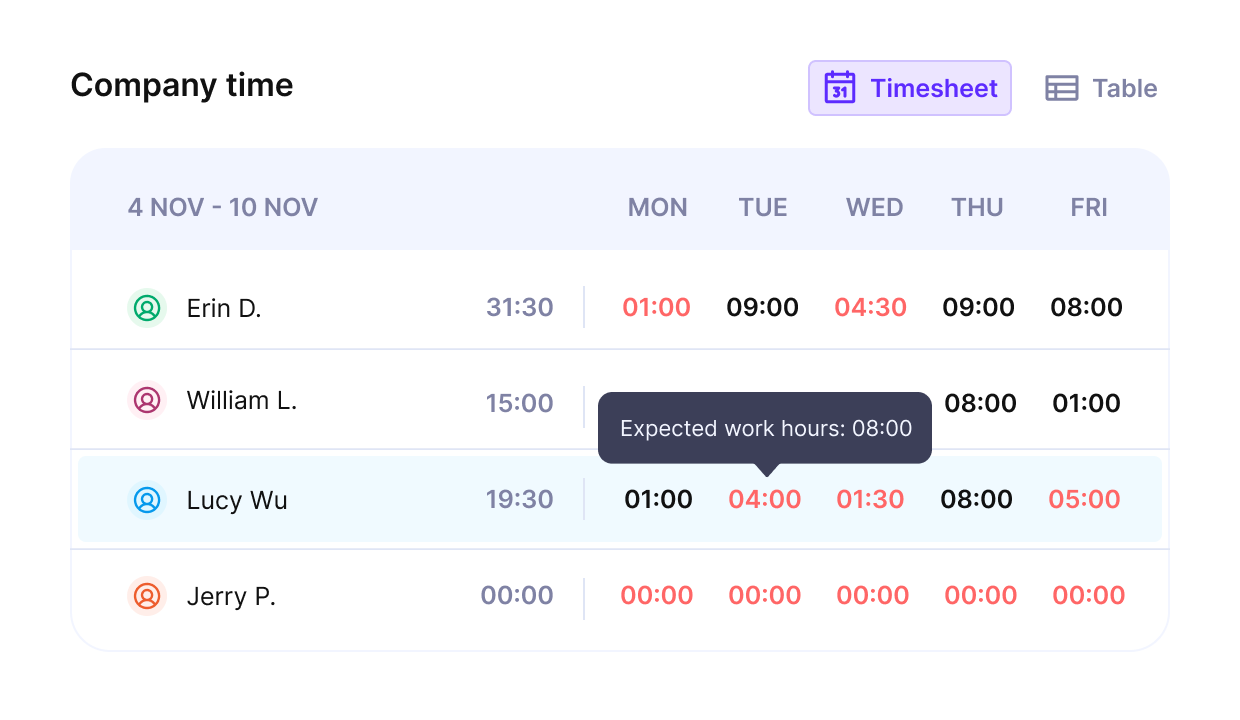
Get real-time updates on employee utilization and workloads.
What Are the Best Tools for Client Relationship Management?
The best tools for client relationship management are project-based CRMs, all-in-one agency platforms, and customizable client databases. These tools help centralize communication, track project status, and store client context in one place.
All-in-one project management software is especially helpful for teams that want to manage delivery, time tracking, budgeting, and reporting in the same tool.
Look for a tool that’s easy to use, integrates with your existing software, and offers the right level of visibility for your team. Demo a few platforms with real data to see how they handle your workflows.
Must-Have Features
- Shared client timelines
- Custom fields for project types and notes
- Task ownership and status tracking
- Email or calendar integrations
- CRM Integrations
- Permission settings based on roles
- Activity logs or audit trails
- Simple reporting dashboards
Productive includes many of these features, along with budgeting and time tracking tools designed for service firms. If you’re looking for more options, we’ve reviewed the top tools in the project management CRM software comparison guide.
How Much Does a CRM Cost?
CRM pricing usually starts between $10 and $30 per user per month, with higher tiers offering automation tools, reporting, or integrations. A more complete CRM platform that supports services and delivery workflows typically runs $40–$60 per user.
Don’t forget about migration and onboarding. Those setup costs can add another few hundred dollars per company.
Final Thoughts
Client relationship management only delivers value when the system is adopted and used consistently.
The best place to start is with a pilot: define what your CRM should support, test it with a small team, and improve the setup before a full rollout. Once it’s part of the routine, you’ll be able to track results and improve relationship management with real data.
If you’re looking for a CRM that ties delivery, budgets, and reporting into one workflow, book a demo with Productive.
Manage client relationships from sales to delivery
Track pipeline, handoffs, budgets, and progress in a single workflow. Productive keeps promises aligned with delivery.
